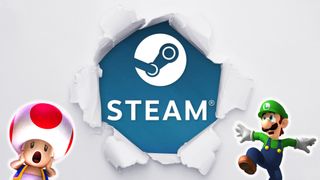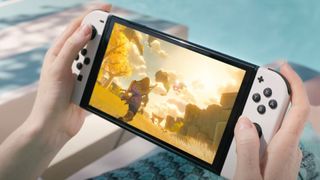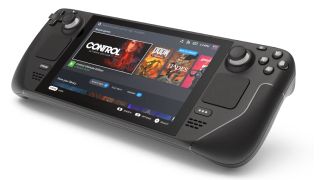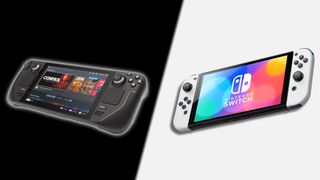Nintendo's dug itself a massive hole with Switch, but the Steam Deck can fill it
Opinion: Nintendo has been resting on its laurels for far too long

Sometimes we all need a little push in life. However, when it comes to the Steam Deck, Valve has given Nintendo an almighty smack around the chops – the type that’s typically seen during a game of Super Smash Bros. Ultimate.
While the Steam Deck is unlikely to send the Switch flying into the abyss like a well-aimed punch from Donkey Kong, a genuine contender for Nintendo’s hybrid console crown was bound to arrive sooner or later.
And truth be told, I think Nintendo can consider itself fortunate that it’s taken this long. The Kyoto-based company has rested on its laurels in recent years with the Switch, and it’s this lack of proactivity that may have given competitors a big edge.
- Steam Deck vs Nintendo Switch OLED: the two handhelds compared
- Best Steam games you can play right now
- Nintendo Switch OLED vs Nintendo Switch: what's the difference?
That might sound like a ridiculous thing to say in the midst of the Nintendo Switch reaching 80 million units sold. But aside from the usual weekly releases of digital download titles, many of which are questionable releases, the Switch’s game output has slowed to a crawl. The biggest games for Switch have consisted mostly of ports from the Wii U, Wii and even Nintendo 3DS, while other “new” titles have been fairly safe remakes of games from generations ago.
The feeling of an overwhelming amount of ports hasn’t been helped by interim releases like Ring Fit Adventure, Game Builder Garage and Nintendo Labo. Even though these titles are innovative in their own right, apart from Ring Fit Adventure, they haven’t found mainstream appeal
Nintendo even had the gall to release Super Mario 3D All-Stars and then remove it from sale, which means this unambitious compilation is no longer available to purchase from the Nintendo Switch eShop and is only available at retailers while stocks last.
Drifting along

Hardware issues have also become more prominent during the Switch’s lifespan, something that isn’t something we tend to associate with Nintendo. The Switch Joy-Con controllers are still prone to developing stick drift, even though it’s been almost five years since the console went on sale (although the issue can seemingly be fixed using a piece of paper).
Get daily insight, inspiration and deals in your inbox
Get the hottest deals available in your inbox plus news, reviews, opinion, analysis and more from the TechRadar team.
This lack of care and attention has also trickled down to the mismanaged Nintendo Switch eShop, and is evident in Nintendo’s paid online service, which continues to be lightyears behind what most players expect in 2021 in terms of reliable multiplayer connectivity and communication. A lack of meaningful system updates for the Switch only adds to the feelings of frustration that the console has stagnated – we still can’t create folders to organize games or access anything beyond two basic themes. It still doesn’t have Netflix, either.
That’s not to say Nintendo has been completely complacent in keeping interest in the Switch high. The company released the Nintendo Switch Lite in 2019, a portable only system aimed at a younger demographic with a cheaper price point. And it even stealthily refreshed the original Switch without any fanfare (such as the Monster Hunter Rise console bundle), significantly improving the battery life.
Time waits for no one

But what was becoming clear, however, was that the Switch was in need of a shot in the arm; a little bit of TLC so to speak. Even though it’s slightly unfair to make direct comparisons, the mere presence of the PS5, Xbox Series X and Xbox Series S only served to show how dated Nintendo’s hardware has slowly become, particularly for those who play the console in docked mode.
Yes, the Switch can run some seemingly impossible ports like The Witcher 3 and Doom, but portability aside, they’re decidedly inferior versions of two great games available elsewhere – and often at a much cheaper price point.
The widely speculated Nintendo Switch Pro would have solved this conundrum, then. Rumors pointed to upgraded specs that promised to increase the performance of existing Switch games, just like the PS4 Pro and Xbox One X successfully reinvigorated the last-gen consoles for Sony and Microsoft. Those who like to play the system docked would have also benefited from the Switch Pro, as it was tipped to deliver a 4K output, matching the resolution that has long become the standard in TVs.
But alas, Nintendo announced the Switch OLED instead, an upgrade that completely missed the mark for many, and is probably only a sensible purchase to those who don’t already own Nintendo’s hybrid console. It makes some pleasing improvements over the original, like a better kickstand, enhanced speakers and, of course, that OLED display. But it’s still the same Switch inside. Stick it in the dock, and those new additions vanish instantly. The OLED screen is gone, as are the other enhancements, and you’ll still be viewing Switch games at a max resolution of 1080p.
Model mistake

With the Switch OLED, then, Nintendo has suddenly generated huge demand for something that it could and should have addressed. Now the door has swung wide open for other companies to enter, and it looks like Valve is more than happy to step in with the Steam Deck.
The Steam Deck beats the Switch in practically every single department from a technical standpoint, and only costs $50 more for the 64GB model – plus it comes with a free carry case. Its appeal is immediately apparent, thanks to Nintendo laying down all the necessary groundwork already. However, Valve is offering more than just a Switch-like alternative.
The power of Steam is what really gets me excited about the Steam Deck. The fact it lets you play your entire Steam library from the get-go is a huge plus, and having access to the Steam Store – which is still the king when it comes to discounts and deals – cannot be understated. PC games are also historically cheaper than on any other platform, even more so now that Sony’s first-party exclusives cost an eye-watering $70 / £70.
And speaking of games, the Steam Deck will be home to both Xbox and PlayStation titles. The likes of Sea of Thieves, Halo Infinite, Death Stranding and Horizon: Zero Dawn are all present on Steam, and will now be playable natively on a portable system.
While Nintendo has fought off equally strong competition in the past in the form of the PSP and PS Vita, which were always hamstrung by stupidly expensive proprietary memory card solutions, Valve’s Steam Deck will have thousands of games to play from day one, has instant appeal, and crucially, the demand for such a device is at fever pitch thanks to Nintendo’s stubbornness to give players more.
It’s time to make a switch

The Steam Deck also does countless things that the Switch can’t. You can turn it into a fully-fledged PC (if you like); connect a pair of Bluetooth headphones; it has features like a proper friends system where you can actually message people; and it also has the kind of pick up and play convenience the Switch is famed for, but the Steam Deck arguably takes it one step further. Cloud saves let you pick up exactly where you left off if you want to play on your powerful home PC or take your Steam Deck on the move, and the ability to output to an external monitor or TV using any USB Type-C dock at a higher resolution is also a boon.
The Steam Deck is more flexible and open as a platform than the Switch is, then, which has sometimes felt like it has held players to ransom by being the only portable device on the market. But soon, there will be a viable and tempting alternative, one that offers superior performance, a wider choice of games, more flexibility and a similar price point. And as someone who has found their Switch feeling more outdated with every passing year, I can’t wait to have a portable device that has the type of modern features I crave and the performance that I expect.
All those independent games like Hades that have found success on Switch will run better on the Steam Deck, cost less, and are usually available first on Valve’s digital storefront. All those triple A games that either skip Switch entirely or come with massive compromises? The Steam Deck will be able to run them without butchering the experience. Craving proper console-like features such as achievements, cloud saves and communicating with friends? To riff on an old Sega marketing slogan: the Steam Deck does what Nintendon’t.
Ace in the hole

Of course, there’s one area where Valve’s Steam Deck will never be able to compete against the Switch, and that’s the appeal of Nintendo’s first-party games. Breath of the Wild 2 is sure to attract countless plaudits when it releases in 2022, and Nintendo’s timeless IP continues to make its console a must-buy for many.
The Steam Deck is a different beast, though. Valve’s handheld PC not only looks the part, but it has numerous advantages over the Switch along with a comparable price point. That’s probably the biggest surprise: the price of the 64GB model makes the Nintendo Switch OLED look even less appealing than some consumers already found it, myself included, and does enough to make people ask questions and make comparisons.
But even if the company behind Half-Life’s handheld PC doesn’t take off, Nintendo has to at least look over its shoulder now some proper competition has arrived. And ultimately, that’s a good thing, as it means Nintendo will have to do far more than it has to retain its position as the number one portable gaming device on the market.
- Nintendo Switch OLED vs Nintendo Switch Lite: which is right for you?
Adam was formerly TRG's Hardware Editor. A law graduate with an exceptional track record in content creation and online engagement, Adam has penned scintillating copy for various technology sites and also established his very own award-nominated video games website. He’s previously worked at Nintendo of Europe as a Content Marketing Editor and once played Halo 5: Guardians for over 51 hours for charity. He is now an editor at The Shortcut.

